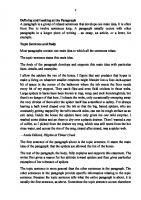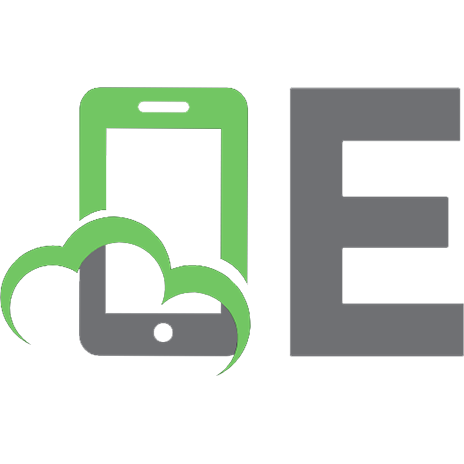Professional Communication in Speech-Language Pathology: How to Write, Talk, and Act Like a Clinician [4 ed.] 1635501687, 9781635501681
In Professional Communication in Speech-Language Pathology: How to Write, Talk, and Act Like a Clinician, Fourth Edition
457 40 12MB
English Pages 286 Year 2020
Table of contents :
Preface
Section I. Introduction to Professional Communication, Clinical Practicum Sites, and Ethics
1. The Nature of Professionalism and Professional Communication
Learning Outcomes
Introduction
Professional Written Communication
Professional Verbal Communication
Shared Components of Professional Written and Verbal Communication
Reflection Questions
2. Learning As They Change Rules: The Many Faces of Clinical Practicum
Learning Outcomes
Introduction
Clinical Settings
The University Setting
The Medical Setting
The School Setting
Reflection Questions
3. Ethics, Confidentiality, and Safeguarding Clinical Communications
Learning Outcomes
Health Insurance Portability and Accountability Act (HIPAA)
American Speech-Language-Hearing Association (ASHA) Code of Ethics
The University Speech and Hearing Clinic
Treatment Plans and Progress Notes
Formal Treatment Reports
Formal Diagnostic Report
Test Forms
Information on Flash Drives Used by Students
Electronic Transmissions
Authorization Forms
Therapy Schedules
Verbal Discussions
Audio/Video Recordings
The Medical Setting
The School Setting
Reflection Questions
Section II. Professional Written Communication
4. Documentation and Technical Writing
Learning Outcomes
The Basics of Writing
Tone and Language
Organization
Common Errors
Remember Your Audience
Editing
Reflection Questions
5. Diagnostic Reports
Learning Outcomes
The Organizational Framework of a Diagnostic Report
The University Setting
The Medical Setting
The School Setting
Reflection Questions
6. Treatment Documentation
Learning Outcomes
What Are Long-Term and Short-Term Goals?
Definition of a Goal
The Importance of Rationales
Data Is Critical
The University Setting
The Integration of Long-Term Goals (LTGs), Short-Term Goals (STGs), and Rationales
The Medical Setting
The Rehabilitation Setting
The Hospital Setting
Long-Term Care/Skilled Nursing Facility
The School Setting
Individualized Education Program (IEP)
Individualized Family Service Plan (IFSP)
How Is the IFSP Different From the IEP?
How Does the IEP Reflect Specific Goals?
Similarities and Differences in Goal Writing Across Settings
Reflection Questions
7. Short-Term Progress Reports
Learning Outcomes
Progress Reports
The University Setting
Example 1: Aphasia Client
Example 2: Child Language Client
Example 3: Child Articulation Client
Example 4: Fluency Client
The Medical Setting
The School Setting
Reflection Questions
8. Long-Term Progress Reports
Learning Outcomes
The University Setting
The Medical Setting
The Rehabilitation Setting
The Hospital Setting
Long-Term Care/Skilled Nursing Facility
The School Setting
Reflection Questions
9. Professional Correspondence
Learning Outcomes
Format/Organization
Phone Correspondence
Reflection Questions
Section III. Professional Verbal Communication
10. Interacting with Clients and Families
Learning Outcomes
Selected Critical Elements of Professional Verbal Communication
Show Respect
Organize
Use Professional Tone
Listen and Understand
Attend To Context
Modify Based On Feedback
The Value of Experience
Contexts of Verbal Communication with Clients and Families
Informational Counseling
Three Important Issues Common to All Diagnostic Interviews
Diagnostic Interviews with Parents
Diagnostic Interviews with Adult Clients and Their Family Members
Methods of Maximizing Retention
Conducting Training Sessions for Developing a Home Treatment Program
Discussing Treatment Progress with Clients and Families
Counseling Clients and Families About Treatment Issues
Personal Adjustment Counseling
Reflection Questions
11. Interacting with Other Professionals
Learning Outcomes
Contexts of Professional Verbal Communication with Other Professionals
Consultations
Staffings and Meetings
Collaboration (Push In and Pull Out)
Solving Problems in Informal Daily Interactions
Making Mistakes
Misunderstandings and Miscommunications
Reflection Questions
12. Interacting with Individuals from Diverse Backgrounds
Learning Outcomes
Introduction
Cultural Competence and the SLP
The Therapeutic Cycle
Reflection Questions
13. Interacting with Supervisors
Learning Outcomes
The Evolution of the Student and Supervisor Relationship Through the Practicum Experience
The Supervisory Relationship
Goals of Supervisors and Students
Critical Differences Between Students and Supervisors
Remember the Principles of Professional Verbal Communication
Communication Issues You May or May Not Encounter
Mistakes Students Make
Generational Differences
Millennials and Technology
Baby Boomers, Generation X, and Generation Z
Reflection Questions
Appendices
A. Samples of University Clinic Diagnostic Report for a Child Client
B. Sample of University Clinic Diagnostic Report for an Adult Client
C. Sample of Inpatient Rehab Assessment Report for Speech/Language/Swallowing
D. Example of a University Clinic Daily Treatment Plan
E. List of Selected Abbreviations Used in School Settings
F. List of Selected Abbreviations Used in Medical Settings
G. Example of a University Clinic Long-Term Treatment Report
H. Examples of Data Sheets
I. Examples of Progress Notes in the SOAP Format
J. Examples of Long-Term Graphs
References
Index
Preface
Section I. Introduction to Professional Communication, Clinical Practicum Sites, and Ethics
1. The Nature of Professionalism and Professional Communication
Learning Outcomes
Introduction
Professional Written Communication
Professional Verbal Communication
Shared Components of Professional Written and Verbal Communication
Reflection Questions
2. Learning As They Change Rules: The Many Faces of Clinical Practicum
Learning Outcomes
Introduction
Clinical Settings
The University Setting
The Medical Setting
The School Setting
Reflection Questions
3. Ethics, Confidentiality, and Safeguarding Clinical Communications
Learning Outcomes
Health Insurance Portability and Accountability Act (HIPAA)
American Speech-Language-Hearing Association (ASHA) Code of Ethics
The University Speech and Hearing Clinic
Treatment Plans and Progress Notes
Formal Treatment Reports
Formal Diagnostic Report
Test Forms
Information on Flash Drives Used by Students
Electronic Transmissions
Authorization Forms
Therapy Schedules
Verbal Discussions
Audio/Video Recordings
The Medical Setting
The School Setting
Reflection Questions
Section II. Professional Written Communication
4. Documentation and Technical Writing
Learning Outcomes
The Basics of Writing
Tone and Language
Organization
Common Errors
Remember Your Audience
Editing
Reflection Questions
5. Diagnostic Reports
Learning Outcomes
The Organizational Framework of a Diagnostic Report
The University Setting
The Medical Setting
The School Setting
Reflection Questions
6. Treatment Documentation
Learning Outcomes
What Are Long-Term and Short-Term Goals?
Definition of a Goal
The Importance of Rationales
Data Is Critical
The University Setting
The Integration of Long-Term Goals (LTGs), Short-Term Goals (STGs), and Rationales
The Medical Setting
The Rehabilitation Setting
The Hospital Setting
Long-Term Care/Skilled Nursing Facility
The School Setting
Individualized Education Program (IEP)
Individualized Family Service Plan (IFSP)
How Is the IFSP Different From the IEP?
How Does the IEP Reflect Specific Goals?
Similarities and Differences in Goal Writing Across Settings
Reflection Questions
7. Short-Term Progress Reports
Learning Outcomes
Progress Reports
The University Setting
Example 1: Aphasia Client
Example 2: Child Language Client
Example 3: Child Articulation Client
Example 4: Fluency Client
The Medical Setting
The School Setting
Reflection Questions
8. Long-Term Progress Reports
Learning Outcomes
The University Setting
The Medical Setting
The Rehabilitation Setting
The Hospital Setting
Long-Term Care/Skilled Nursing Facility
The School Setting
Reflection Questions
9. Professional Correspondence
Learning Outcomes
Format/Organization
Phone Correspondence
Reflection Questions
Section III. Professional Verbal Communication
10. Interacting with Clients and Families
Learning Outcomes
Selected Critical Elements of Professional Verbal Communication
Show Respect
Organize
Use Professional Tone
Listen and Understand
Attend To Context
Modify Based On Feedback
The Value of Experience
Contexts of Verbal Communication with Clients and Families
Informational Counseling
Three Important Issues Common to All Diagnostic Interviews
Diagnostic Interviews with Parents
Diagnostic Interviews with Adult Clients and Their Family Members
Methods of Maximizing Retention
Conducting Training Sessions for Developing a Home Treatment Program
Discussing Treatment Progress with Clients and Families
Counseling Clients and Families About Treatment Issues
Personal Adjustment Counseling
Reflection Questions
11. Interacting with Other Professionals
Learning Outcomes
Contexts of Professional Verbal Communication with Other Professionals
Consultations
Staffings and Meetings
Collaboration (Push In and Pull Out)
Solving Problems in Informal Daily Interactions
Making Mistakes
Misunderstandings and Miscommunications
Reflection Questions
12. Interacting with Individuals from Diverse Backgrounds
Learning Outcomes
Introduction
Cultural Competence and the SLP
The Therapeutic Cycle
Reflection Questions
13. Interacting with Supervisors
Learning Outcomes
The Evolution of the Student and Supervisor Relationship Through the Practicum Experience
The Supervisory Relationship
Goals of Supervisors and Students
Critical Differences Between Students and Supervisors
Remember the Principles of Professional Verbal Communication
Communication Issues You May or May Not Encounter
Mistakes Students Make
Generational Differences
Millennials and Technology
Baby Boomers, Generation X, and Generation Z
Reflection Questions
Appendices
A. Samples of University Clinic Diagnostic Report for a Child Client
B. Sample of University Clinic Diagnostic Report for an Adult Client
C. Sample of Inpatient Rehab Assessment Report for Speech/Language/Swallowing
D. Example of a University Clinic Daily Treatment Plan
E. List of Selected Abbreviations Used in School Settings
F. List of Selected Abbreviations Used in Medical Settings
G. Example of a University Clinic Long-Term Treatment Report
H. Examples of Data Sheets
I. Examples of Progress Notes in the SOAP Format
J. Examples of Long-Term Graphs
References
Index
![Professional Communication in Speech-Language Pathology: How to Write, Talk, and Act Like a Clinician [4 ed.]
1635501687, 9781635501681](https://ebin.pub/img/200x200/professional-communication-in-speech-language-pathology-how-to-write-talk-and-act-like-a-clinician-4nbsped-1635501687-9781635501681-n-4898140.jpg)
- Author / Uploaded
- A. Embry Burrus
- Laura B. Willis
![Professional Communication in Speech-Language Pathology: How to Write, Talk, and Act Like a Clinician [4 ed.]
1635501687, 9781635501681](https://ebin.pub/img/200x200/professional-communication-in-speech-language-pathology-how-to-write-talk-and-act-like-a-clinician-4nbsped-1635501687-9781635501681.jpg)



![How to Write Effective Business English: Your Guide to Excellent Professional Communication [4 ed.]
1398609951, 9781398609952](https://ebin.pub/img/200x200/how-to-write-effective-business-english-your-guide-to-excellent-professional-communication-4nbsped-1398609951-9781398609952-t-2735286.jpg)
![How to Write Effective Business English: Your Guide to Excellent Professional Communication [4 ed.]
1398609951, 9781398609952](https://ebin.pub/img/200x200/how-to-write-effective-business-english-your-guide-to-excellent-professional-communication-4nbsped-1398609951-9781398609952.jpg)



